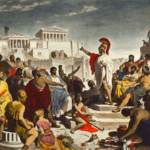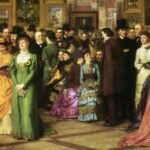Christmas may get buried under the catalogues of holiday cheer, present buying, and a lot of food prep stress, but the 2 thousand-year-old holiday commemorating the birth of Jesus has one of the most complex and interesting timelines of any holiday in the history of the world.
The annual festival celebrated on Dec. 24, Dec. 25, January 7, and Jan 19 depending on denomination, is both a cultural and deeply religious occasion celebrated by billions of people around the world. From the inclusion of the Christmas tree to the annual gift-giving, the feast day that spans through modern history has many traditions, myths, and stories that resonate around the globe.
Recommended Reading
The Great Irish Potato Famine
Boil, Bubble, Toil, and Trouble: The Salem Witch Trials
The History of Christmas
As a main celebration in the Christian liturgical calendar, it follows the season of Advent and ushers in Christmastide, or The Twelve Days of Christmas. It was first decided to the specific date in the Western calendar by Dionysius Exiguus, a Scythian monk who was an abbot in Rome. With Exiguus’ research and biblical texts, Jesus’s birth was decided to have occurred on December 25, 1 C.E. There have been many disputes over the actual date of Jesus’s birth since, but Exiguus’ date has stuck despite them.
Prior to Christian celebrations, Roman pagans celebrated the holiday of Saturnalia, a week of raucous celebrations from December 17-25, where Roman courts were closed and the law dictated that citizens could not be punished for damaging property or injuring people during the feasting. The Romans believed these celebrations, which chose a community victim and forced them to indulge in food and festivities, destroyed the forces of evil when they murdered this victim at the conclusion of the week, on December 25.
In the 4th century, Christian leaders were successful at converting many pagans to Christianity by allowing them to also continue the celebration of Saturnalia, and this was its first connection to Jesus’s birth. Because the festival of Saturnalia had no connection with Christian teachings, leaders tacked on the holiday of Jesus’s birth onto the last day of the festival. For many years, contemporaries of the time continued to allow the celebration to continue in its lawless way—with drinking, sexual indulgences, singing naked through the streets. Many modern traditions have arisen from Christmas’s early beginnings, however, such as caroling (we’ve just decided to wear clothes), and the eating of human-shaped biscuits (we just call them Gingerbread men now).
Though the pagan celebrations died out as the pagans were converted to Christians, Puritans did not observe the holiday due to its non-Christian origins. Other Christians however, continued to celebrate Saturnalia and Christmas together, perfectly willing to have pagan holidays turned into Christian ones as more people converted to Christianity. During 1466 under the direction of Pope Paul II, Saturnalia was intentionally revived to coincide with Christmas celebrations, and at the amusement of Rome, Jews were forced to run naked through the streets of the city. Well into the late 1800’s, Christian leaders and the religious community embarked on anti-Semitic abuse of Jews in Europe, including Rome and Poland, and condoned the murder, rape, and maiming, of Jews during the celebrations marking the birth of Jesus.
When the Saxons, the Germanic tribes of Europe, were converted to Christianity, they brought the word “yule,” meaning mid-winter, with them to include in Christmas traditions. In the following years, yule became to be defined as Jesus’s birthday, but it was not used until the 11th century. For many centuries, Europeans continued to celebrate the season by burning a Yule log in the fireplace, and light a Yule candle, rather than following any of the customs many associate with Christmas today.
In fact, many Christmas traditions of Europe, and America were not defined until the mid-19th century and were not deemed to be particularly important prior until many years later. What many look forward to at Christmas celebrations today, such as caroling, card giving, and tree decorating, were solidified during the 19th century throughout Europe and America.
Latest Society Articles
Who Invented Democracy? The True History Behind Democracy
Medieval Fashion: Tunics, Underclothes, Pointed Shoes, and More!
37 Underground Cities: The Hidden Pillars of Civilization
Santa Claus, one of the most recognizable Christmas traditions and one that was added during the mid-19th century, is one that originates very early in the Christian timeline. Nicholas, born in in Parara, Turkey in 270 CE, would become the Bishop of Mara and later, after his death, the only saint named in the 19th century. One of the senior bishops who attended the Council of Nicaea in 325 CE, which created the New Testament texts, he was well-liked and very popular at the time, achieving cult status.
In 1087, a group of sailors enshrined his bones in a sanctuary in Italy, replacing a local deity known as “The Grandmother,” who was regarded by the community as a benevolent deity who filled children’s socks and stockings with gifts. Members of the cult gathered here and celebrated Nicholas’s death every December 6. Later, the cult and reverence for the saint spread north to reach the Germanic and Celtic pagans, where his figure combined with Woden, the chief God of Germanic tradition. Losing his swarthy, Mediterranean looks, Nicholas’s appearance took on that of Woden, one with a long white beard, riding a winged horse, and picking up cold weather clothing. As the Catholic Church bid for converting the pagans in Northern Europe, they accepted the celebrations for Saint Nicholas but moved his feasting day from December 6 to December 25.
READ MORE: Celtic gods and goddesses
It wasn’t until Washington Irving’s Knickerbocker History in 1809, a satire of Dutch culture, that St. Nick resurfaced. Referring to a white-bearded, horse-flying St. Nick, whom the Dutch called Santa Claus, Irving brought the character back into popular culture. Less than 20 years later, Union Seminary professor Dr. Clement Moore read Knickerbocker History and penned “Twas the Night Before Christmas,” where St. Nick’s place in historical myth was once again evolved. Popping down chimneys and being carried on a sleigh by eight reindeer, Moore’s St. Nick is the one that was used by Coca-Cola in 1931 dressed in Coca-Cola red and sporting a jolly face to much acclaim. And as they say, thus was born the Father Christmas we recognize today; a Christian saint, Pagan god, and commercial ploy.
The Christmas tree, was also a pagan tradition, one where the Asheira cult, Druids, and their offshoots, had long worshiped trees in the wild, or brought them into their homes and decorated them in reverence for natural gods. Early Christians recruited the Asheira, similar to their recruitment of pagan Romans, to readapt this tradition into one that was accepted and adopted by the Church. In the mid-19th century, trees became to become a massively popular Christmas item all over Europe and America.
The gifting that is associated with the holidays has a murkier past, one that is associated both with the Wise Men who visited Jesus bringing gifts, St. Nicholas, and the original Saturnalia celebrations that Christmas derived from. During Roman times, emperors urged their most hated citizens to bring offerings to them, which later expanded to gift giving among the larger populace. Later this was transformed into a Christian custom under the tales of St. Nicholas’s gift giving myths. When Christmas saw it’s resurgence in popular culture during the mid-19th century, gifts were often nuts, popcorn, oranges, lemons, candies and homemade trinkets, far from the huge offerings people see in stores and under Christmas trees today.
Explore More Society Articles
History of Valentine’s Day: The Dark Origins of Valentine’s Day and Why We Celebrate It
History of Mother’s Day: The Origin Story Behind Mother’s Day
Who Invented Pizza: Is Italy Truly the Birthplace of Pizza?
Victorian Era Fashion: Clothing Trends and More
The History of Guns in American Culture
An Ancient Profession: The History Of Locksmithing
For those looking to make a splash at this year’s Christmas festivities and dinners, this history will certainly give you something to talk about when the conversation goes cold at the table, as it’s full of little-known facts many people are unaware of!












Hi, Great post!